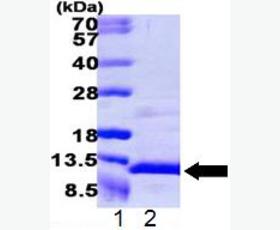Recombinant Human Nogo-66 Receptor-Related 3/NgR3/RTN4RL1
| Product name: | Recombinant Human Nogo-66 Receptor-Related 3/NgR3/RTN4RL1 |
| Source: | Human Cells |
| Purity: | Greater than 95% as determined by reducing SDS-PAGE. |
| Buffer Formulation: | Lyophilized from a 0.2 μm filtered solution of 20mM PB, 150mM NaCl, 5% Threhalose, pH 7.2. |
| Applications: | Applications:SDS-PAGE; WB; ELISA; IP. |
| Storage: | Avoid repeated freeze/thaw cycles. Store at 2-8 oC for one month. Aliquot and store at -80 oC for 12 months. |
| UOM: | 100ug/50ug/200ug/1mg/1g |
| Source | Human Cells |
| Description | Recombinant Human NgR3 is produced by our Mammalian expression system and the target gene encoding Cys25-Ala419 is expressed with a 6His tag at the C-terminus. |
| Names | Reticulon-4 Receptor-Like 1, Nogo Receptor-Like 2, Nogo-66 Receptor Homolog 2, Nogo-66 Receptor-Related Protein 3, NgR3, RTN4RL1, NGRH2, NGRL2 |
| Accession # | Q86UN2 |
| Formulation | Lyophilized from a 0.2 μm filtered solution of 20mM PB, 150mM NaCl, 5% Threhalose, pH 7.2. |
| Shipping |
The product is shipped at ambient temperature. |
| Reconstitution |
Always centrifuge tubes before opening. Do not mix by vortex or pipetting. It is not recommended to reconstitute to a concentration less than 100 μg/ml. Dissolve the lyophilized protein in ddH2O. Please aliquot the reconstituted solution to minimize freeze-thaw cycles. |
| Storage |
Lyophilized protein should be stored at < -20°C, though stable at room temperature for 3 weeks. Reconstituted protein solution can be stored at 4-7°C for 2-7 days. Aliquots of reconstituted samples are stable at < -20°C for 3 months. |
| Biological Activity |
IN STOCK |
| Purity |
Greater than 95% as determined by reducing SDS-PAGE. |
| Endotoxin | Less than 0.1 ng/µg (1 IEU/µg) as determined by LAL test. |
| Amino Acid Sequence |
CPRDCVCYPAPMTVSCQAHNFAAIPEGIPVDSERVFLQNNRIGLLQPGHFSPAMVTLWIYSNNIT YIHPSTFEGFVHLEELDLGDNRQLRTLAPETFQGLVKLHALYLYKCGLSALPAGVFGGLHSLQYL YLQDNHIEYLQDDIFVDLVNLSHLFLHGNKLWSLGPGTFRGLVNLDRLLLHENQLQWVHHKAFHD LRRLTTLFLFNNSLSELQGECLAPLGALEFLRLNGNPWDCGCRARSLWEWLQRFRGSSSAVPCVS PGLRHGQDLKLLRAEDFRNCTGPASPHQIKSHTLTTTDRAARKEHHSPHGPTRSKGHPHGPRPGH RKPGKNCTNPRNRNQISKAGAGKQAPELPDYAPDYQHKFSFDIMPTARPKRKGKCARRTPIRAPS GVQQAVDHHHHHH
|
| Background | Nogo-66 Receptor-Related Protein 3 (NgR3) has primary structures with NgR2 (NgRH1, NgRL3) and biochemical properties that are homologous to Nogo-66 receptor (NgR), and constitute a novel neuronal receptor protein family. NgR is GPI-anchored and contains eight leucine-rich repeats (LRR), it is the neuronal receptor for the myelin- associated proteins Nogo-A, OMgp (oligodendrocyte myelin glycoprotein), and MAG (myelin-associated glycoprotein) and mediates the inhibition of CNS axonal regeneration both in vitro and in vivo. NgR2 and NgR3 have similar structure and distinct but overlapping expression versus NgR. NgR2 can be metalloproteinase-cleaved to release a soluble ectodomain. NgR2 has also been shown to bind MAG, but ligands for NgR3 have not yet been determined. Mature huaman NgR3 shares 88%, 88%, 48% and 44% amino acid identity with mature mouse NgR3, rat NgR3, human NgRH1 and NgR, repectively. |














